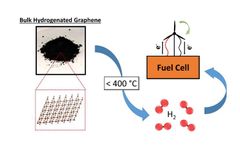hydrogen storage Articles
-
Recent achievements on materials for hydrogen storage
After a brief introduction on the problems related to hydrogen storage, recent trends of the research on hydrogen storage materials are presented and discussed: metal hydrides; nanostructured magnesium-based hydrides; nanocomposites based on mixtures of amides and hydrides, amides and alanates, and borohydrides and hydrides; chemical hydrides; and nonhydride systems. The aim of the paper is to ...
-
The search for novel hydrogen storage materials: a theoretical approach
Density Functional Theory (DFT) is a powerful tool to predict the crystal structure of hitherto experimentally unknown phases. In this article, we demonstrate the predicting capability of DFT on the structural properties of hydrogen storage materials from different input structure models. An experimentally known structural framework is successfully reproduced for NaMgH3 and the positional and ...
-
Hydrogenated Graphene for Hydrogen Storage Applications
Fully hydrogenated graphene, termed “graphane”, is composed of 7.7 % hydrogen by mass, and possesses unique physical, electrical, and optical properties. Like graphene however, pristine graphane is challenging to isolate in bulk form. However, graphite and similar carbon allotropes can be chemically hydrogenated to yield similar materials which are colloquially termed hydrogenated ...
-
Magnesium-nickel hydrogen storage alloys prepared by hydriding combustion synthesis followed by mechanical milling
Recent progress is reviewed in the preparation of highly active magnesium-based hydrogen storage alloys by the combined process of Hydriding Combustion Synthesis (HCS) and Mechanical Milling (MM). The structural transformation of the alloys during MM determined by means of X-ray Diffraction (XRD) and the hydrogen storage properties of the alloys measured by means of ...
-
Standards for hydrogen refueling stations
At the end of May 2004, International codes council (ICC) has approved several standards relating to hydrogen storage in refueling station. The ICC fire code now allows for liquid hydrogen storage in insulated underground ...
-
Electrochemical hydrogen storage characteristics of TiVNi–quasicrystalline composite materials
The Ti1.4V0.6Ni ribbon alloy and VTZN (V5Ti9Zr26.7Ni38Cr5Mn16Sn0.3) alloy ingot are prepared by melt–spinning technique and induction levitation melting technique, respectively. The Ti1.4V0.6Ni + 20 wt.% VTZN mixture powders are synthesised by ball–milling the above prepared alloy ingots, and their structures and the electrochemical hydrogen storage properties are investigated. It is ...
-
Kinetic behaviour of a metal-polymer composite suitable for hydrogen storage applications
Hydrogen storage in composite materials is a feasible way to overcome the main drawbacks of the metal hydride systems. In the present paper, we report on the hydrogenation properties of three polydimethylsiloxane (PDMS)–palladium composite samples with different content of metallic fraction (5, 15, 50 in wt.%). Hydrogenation tests in different conditions of temperature and pressure were ...
-
Gaseous release in LiNH2–MgH2 systems
Hydrogen is considered a safe and clean alternative to fossil fuels. Hydrogen storage is currently obtained by compressing the gas at high pressure. Researchers are currently attempting to tackle safety and energy density issues by locking hydrogen into solids, packing large quantities into small volumes. However, most of the known solids (i.e. intermetallics) show very low gravimetric density, ...
-
The location of Ti atom in sodium alanate: an ab initio spin-polarised study
In this work, ab initio spin-polarised Density Functional Theory (DFT) calculations are performed to study the interaction of a Ti atom with a NaAlH4(001) surface. We confirm that an interstitially located Ti atom in the NaAlH4 subsurface is the most energetically favoured configuration as recently reported (Chem. Comm. (17) 2006, 1822). On the NaAlH4(001) surface, the Ti atom is most stable when ...
-
What Hydrogen Storage is Best for Me?
There are a number of different Hydrogen storage options available. The one which is best for you depends on what is most important for your application: Compressed Economical Readily Available Metal Hydride (MH) High volumetric density (kg H2/ft3) Heavy May need more advanced controls (heat/cool, etc) BoroHydrides High volumetric density Lighter than MH FAA approved ...
-
The possibilities for hydrogen production from H2S and storage in the Black Sea
The Black Sea, a highly isolated inland sea, is the largest anoxic zone in the world. Since the hydrogen sulphide (H2S) zone was discovered in the early 19th century in the Black Sea, it has been accepted that there is no life in the depths of the Black Sea and only bacteria live in the H2S layer. A high content of organic matter, with maximum processes of bacterial sulphate reduction, is the ...
-
Hydrogen storage systems for automotive applications: project StorHy
Around two thirds of world's oil usage is associated with transportation with road vehicles consuming around 40%. Also, transportation accounts for around 25% of greenhouse emissions worldwide, with around 90% coming from road vehicles. This situation is further complicated by the fact that oil reserves are running out. For this reason, the automotive industry supported by relevant governing ...
-
Behaviour investigation of hematite nanorods synthesised by hydrothermal method use in hydrogen fuel storage
For the first time, hematite nanorods were successfully synthesised using iron nitrate precursors in the presence of cation SO4−2. This is also the first time that an investigation into hematite nanorods behaviour for hydrogen fuel storage has been carried out. Microspheres constructed with α-FeOOH nanorods were synthesised via a novel hydrothermal method using a mixture of Fe(NO3)3 · 4H2O and ...
-
Unveiling the Future of Hydrogen Storage: Gas Analysis for Safety and Efficiency
Introduction: As the world transitions towards a cleaner and more sustainable energy future, hydrogen emerges as a key player in the realm of energy storage and transportation. However, efficient and safe storage of hydrogen remains a significant challenge. Gas analysis plays a crucial role in ensuring the safety and efficiency of hydrogen storage systems. In this blog post, we delve into the ...
-
Rare earth intermetallic compounds
Rare-earth intermetallic compounds are metal compound phases formed between rare-earth metals and other metals or similar metals. They mainly use the special physical and chemical properties of rare-earth intermetallic compounds to prepare new rare earths for various purposes using various processing and manufacturing techniques. Functional Materials. At present, there are the following rare ...
-
Preparation and characterization of nickel based catalysts for partial oxidation of methane
Hydrogen, which can be used in many fields without polluting the environment, is thought to be the cleanest fuel source of 21th century. Therefore, low cost production, facile storage and transportation of hydrogen are important research subjects that are investigated by many universities and related commercial facilities. Steam-hydrocarbon reforming is the major hydrogen production process ...
-
Designing a sustainable hydrogen energy economy
A general vision of a sustainable energy economy relying substantially on hydrogen produced from renewables is sketched as a potential solution to the twin global crises of climate change and depleting oil reserves. Core differences between this 'sustainable hydrogen economy' (SHE) and the original hydrogen economy (HE) proposed in the early 1970s are discussed. In transport, rather than posing a ...
-
Hydrogen production from formic acid solution by modified TiO2 and titanate nanotubes in a two-step system under visible light irradiation
Hydrogen gas is one of the most promising renewable energy sources, and the final product of hydrogen combustion is nothing but water. However, it is still a big challenge to produce hydrogen and store it. Many studies have been conducted into produce hydrogen from water using photocatalysts. Z-scheme photocatalysis is a two-photocatalyst system that comprises a hydrogen catalyst and an oxygen ...
-
Scenarios for the role of hydrogen in a future energy system based on renewable energy
An all-renewable energy system for a group of North European countries is investigated by temporal simulation of the demand-supply matching for various system configurations. The role of hydrogen technologies for energy storage and fuel cell applications is studied and applied to both stationary and transportation sectors. It is shown that there is scope for considerable amounts of energy trade ...
-
The technoeconomic assessment of the hydrogen fuel chain
Options for hydrogen fuel chain are compared with the existing petroleum-based fuel chain for transportation. The criteria used are the life cycle cost (Rs/km), Greenhouse Gas (GHG) emissions (g/km) and Nonrenewable Energy (NRE) consumption (MJ/km). Four hydrogen production methods, one hydrogen transport method, three hydrogen storage methods and two on-board energy conversion methods are ...
Need help finding the right suppliers? Try XPRT Sourcing. Let the XPRTs do the work for you



